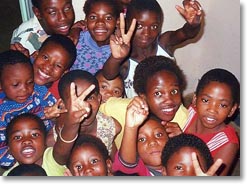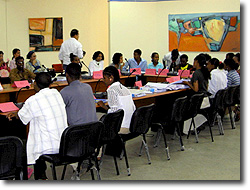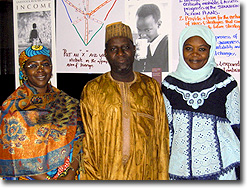Blog
Destination Ethiopia - Oct 31th, 2007
Addis Ababa, Ethiopia was the setting for Leadership Enterprises most recent collaboration with the International Health Program's work with transformative leaders from five countries — Ethiopia, India, Nigeria, Pakistan and Philippines. Teams from each country were invited to a follow-on program designed to strengthen their capacity to affect policy and service delivery in family planning and reproductive health. The program offered an opportunity to assess progress on the strategic action plan they had developed in 2006, to exchange ideas and strategies especially in broadening their networks and undertaking collaborative projects within each country. In addition sessions continued to emphasize individual development and cross-country relationships particularly in Africa and Asia.
An important aspect of the program was an opportunity to witness work going on in Ethiopia. Pictured here are two of those field experiences: a visit to the Autism Center and a student youth program. Our third field visit, appropriately not filmed, was to tour the world famous Fistula Hospital that focuses on repairing damaged tissue commonly the result of early marriage and early pregnancy. Without surgery these girls would remain outcasts throughout the rest of their lives. The Fistula Hospital is situated in Addis Ababa and now expanded to double its size with great credit to another of the Fellows we worked with in the International Family Planning Leadership Program. Dr. Mulu Muletta personally conducted our tour and spoke with passion and great knowledge of the work they are doing in this major health issue for women in developing countries.
The work we have been privileged to do in partnership with International Health Programs reinforces our philosophy that our job is to develop individual leaders and offer them frameworks and models with which to work on problems and opportunities specific to their situations. Such basic work then launches their creativity and energy and inspires them to a personal freedom that is infectious and pervasive across generations.
The Autism Center is the only such effort in Ethiopia initiated by a woman whose autistic son propelled her into creating a school for autistic children. In addition her awareness of the needs of teen-age youth provoked her to open a School of Beauty where older adolescents are trained and then placed in salons across the city. Our visit to the Center inspired the Transformative Leaders to contribute one tuition for a student in the beauty school and several of the leaders committed to return to their countries to investigate what they might do for autistic children.
A second field visit was several miles south of Addis Ababa to see the German Foundation for World Population's training center. We witnessed a student leadership development program that utilizes a curriculum created through the initiative of several of the Fellows of the IHP program for leadership development, which we have co-facilitated with Roger Shaff, Director International Family Planning Leadership Program, over the past six years. The students were eager and energetic participants and spoke eloquently of their desire to lead change in the country. The exciting part of the visit to the student program was the recognition that our initial work with small teams of leaders in reproductive health and family planning has led to task forces and programs that span other aspects of change and development in the country of Ethiopia. Similar initiatives are being launched in the other countries participating in the IHP programs.
posted by
Fran Deutsch at
04:53:02 PM
permalink
| comments
Mining Teams - March 31th, 2007
A mining company is struggling with the formation of teams in an effort to have a fully salaried workforce. The challenge is to facilitate the teaming effort and the conversion to a salaried workforce, while enhancing creativity in the way daily operations are carried out. The independent more isolated nature of a mining town seemed reflected in how the hourly workers approached their assignments. The hope is by formally changing the structure of their employment that responsibilities and accountability could shift along with an emphasis on team rather than the individual. All this is to be carried out while safety is put first and efficiency and effectiveness are addressed.
With the special circumstances of location and history and special skills that the teams needed to have to work in the mining environment, Leadership Enterprises constituted a group of professionals to function as a unit to execute programs and participate in follow-up.
A program was designed to deal directly with conflict resolution styles and a simulation was provided to have the participants engage in action learning. Members of each of the naturally formed 20 teams met in small groups for individual coaching sessions to enhance team work and creativity. The program had several components so individuals could express their perceptions of others, practice their own style, and work together toward some common goals. Each session had a topic focus and purposeful outcomes. The programs were repeated until approximately 240 people participated. Group Profiles were constructed for teams; team coaching follow-up occurred; and the desired outcomes were attained.
Debriefing occurred with senior managers to determine potential next steps and likely priorities given company needs. Some follow-up phone coaching and on-site mediation were used to provide additional resources for several individuals. The organization was encouraged to grow their own training and facilitation capabilities by hiring internal personnel. Some assistance was offered during this successful transition.
posted by
Fran Deutsch at
01:22:43 PM
permalink
| comments
A 360 Hummingbird - February 28th, 2007
A financial organization needs to provide feedback to senior executives. No system existed in the company. The challenges were: 1) what 360 instrument; 2) how is the process rolled out: and 3) how is the system sustained.
Conversations were held with middle management and senior level executives. Input from the senior management team was solicited. An open forum was held for employees. Information was gathered regarding what areas the 360 should include and the type of instrument that would match the corporate culture best. Several instruments were identified, a prioritized recommendation was made and one was selected.
The company needed 200+ people to go through the feedback process in about a 5 month period of time. Meeting timelines and budget considerations, Leadership Enterprises utilized a network of professional associates to provide one-on-one feedback from the 360 instrument. Individuals were prepared for the feedback experience by completing a group 360 orientation meeting and reviewing their data ahead of time.
In order for our feedback system to take flight, we needed to crank up feedback while minimizing ‘rater fatigue’ – the condition where the rater has done so many 360s for so many individuals that all sorts of dire consequences result from not reading questions, giving a preponderance of 3’s to laying out several instruments in a row and completing them for all at one time. Although it sounds humorous, ‘rater fatigue’ is a serious issue.
As a result of this phenomenon, who would be answering for whom was seriously considered. Individuals who were peers, who had their own direct reports, and who were a boss’ direct reports were the most vulnerable. A system was devised to limit the number of assessments any one person could have at one time and to a turn-around for completing instruments. No one fell out of the nest.
With the standard for group orientation sessions in place and several of the organization’s human resource professionals trained up to conduct future sessions and provide feedback, a system for sustaining the feedback in the company was achieved. Group data and overall organizational data were provided. Appropriate issues were being raised: How do we incentivize our people? Do we provide appropriate reward and recognition? How might we connect personal development to performance? How might 360s be placed throughout the entire company? The organization was humming. This effort was one small and mighty step toward developing leadership capacity throughout the organization. Like the hummingbird with 600 beats a minute and insatiable appetite the company was moving.
posted by
Fran Deutsch at
11:42:11 AM
permalink
| comments
Are Meltdowns Possible? - January 31th, 2007
The phone rings. . . “What can you do with an ice lady?” After several conversations with her peers, direct reports, colleagues, and boss issues of style were revealed. Co-workers reported about her know-it-all-attitude, impatience, interruptions on her terms, focus on detail, demands when schedules were already overburdened, abrupt, direct, biting observations. While direct reports revealed “shivering in boots” when she would click, clack down the hall in heels because someone was going to “get it.” Never a kind word, praise, or appreciation for jobs well done. Always a could have been faster, better, more precise and so forth. She called it “constructive criticism” but it felt like destructive attack to them. Some days she would be more tolerable than others and hence she even was referred to popsicle versus iceberg to let folks know what kind of mood they were going to be facing. A language evolved that actually bonded people in their effort to cope with “the ice lady.” Her boss said: “She is my right arm on most days and on the others she can be both because she is that good at what she does.” He praised her ability to wrestle insurmountable tasks with skill, fortitude, and adeptness. But he bemoaned: “Oh the people. She filets them. She publicly puts them down. And, when I ask her about doing so she says: Why not. They are there. I’m there. It saves time and they are adults. I’m not dealing with children.”
All these comments were summarized in a confidential and anonymous report letting her know the perceptions of each group of individuals. The boss had agreed to the benefit of his comments being clearly identified.
After one year of extensive executive coaching with face-to-face, site visits, and phone contacts, perceptions were reported to shift. With the test of time, individuals indicated: “They believe what they see.” The ice lady no longer was having meltdowns but rather was thawing consistently across situations and with different people. Individuals no longer felt uncomfortable when they heard her heels on the floor. Direct reports were waiting for a reversal under stress but it did not occur. The client reported feeling more content and satisfied with her work and life. She had been estranged from her son and decided to initiate contact. That relationship was on the mend as was her personal life that she had no time for before the coaching.
New hires began to wish they were working for her. The grapevine started to talk about her amazing change. Individuals could be heard: “She’s not even an ice cube.”
This senior officer was reported contributing greatly to the organization. As time continued to pass, she was eventually recruited for a bigger job but not before she prepared a successor.
At her send off dinner, there were many wet eyes. . . she introduced her son and fiancé.
posted by
Fran Deutsch at
10:04:17 AM
permalink
| comments
Intellectual Property: How Tangible is it? - December 30th, 2006
Many academics have grasped the superior economic value of intellectual over tangible property in today’s economy. A recent book by Henry Chesbrough, titled Open Business Models, has got me thinking. He, by the way, is the director of the Center for Open Innovation at the University of California, Berkeley. The Core of his book is a taxonomy of six business models that manage innovation with increasingly more effectiveness and efficiency.
- Type 1 companies focus on price and availability as they sell commodities along with others in the industry.
- Type 2 companies use reactive strategies to differentiate their products from competitors; however, innovation is purely happenstance.
- Type 3 organizations plan innovation with its focus products.
- Type 4 organizations allow themselves to have input from external sources; they open up selectively assimilating ideas into internal operations.
- Type 5 companies’ ‘Holy Grail’ is the search for unmet needs. These firms study, examine, and analyze all processes; they integrate suppliers and customers into their analyses; they focus on supply chains and customer satisfaction. There is a continuous need for refinement and improvement.
- Type 6 companies are more fluid with ‘the dance’ synchronizing movements with suppliers and customers. Partnerships move to joint ventures where ideas move more freely making spin-offs more likely.
And so, I started thinking about ‘intellectual property.’ What does it mean? What could it mean? Mr. Chesbrough seems to mean focus on the concrete as in patents. In my experience one of the strongest areas of IP is – the human spirit and the energy that people bring and share. I was so struck by this during my work in South Africa. No matter the circumstance, such as the devastating AIDS epidemic, the people were strong of spirit and resilient. They celebrated with artwork on fences, theatrical productions, and their care of each other.
 I ponder the incredible impact of the Bill Gates Foundation. Imagine turning the tide globally with AIDS and Malaria. And, then there is the intangible impact -- the way he wishes to operate the Foundation – to have it self-destruct in 50 years or to serve its mission fully not holding back. Now that is one mighty intangible. Perhaps there should be a Type 7 that focuses on raising the global bar of heath and welfare.
I ponder the incredible impact of the Bill Gates Foundation. Imagine turning the tide globally with AIDS and Malaria. And, then there is the intangible impact -- the way he wishes to operate the Foundation – to have it self-destruct in 50 years or to serve its mission fully not holding back. Now that is one mighty intangible. Perhaps there should be a Type 7 that focuses on raising the global bar of heath and welfare.
How could we and should we thinking about IP?
posted by
Fran Deutsch at
01:51:32 PM
permalink
| comments
“Yabba-dabba-doo!” - December 30th, 2006
“Yabba-dabba-doo!” “I hate those meeces to pieces!” “Smarter than the average bear!” These catch phrases are well known among the crowd who grew up on Joe Barbera’s and Bill Hanna’s. Any bells ringing? These two guys wrote Tom and Jerry. What’s not much known about them is that despite accolades, 13 Oscar nominations and seven wins, they lost their jobs at MGM when the cartoon studio closed in the late ‘50s
 One of life’s long perplexing questions: What to do when given lemons? Some make lemonade, but there is lemonade and there is lemonade. These guys persisted, adapted, and went on to make Augie Doggy and Doggie Daddy, Yogi Bear and Boo Boo, Pixie and Dixie, Ruff and Reddy or the Flintstones and the Jetsons. It seemed that their formula for success was the dynamics of the ‘buddy system’ or the workings of a team.
One of life’s long perplexing questions: What to do when given lemons? Some make lemonade, but there is lemonade and there is lemonade. These guys persisted, adapted, and went on to make Augie Doggy and Doggie Daddy, Yogi Bear and Boo Boo, Pixie and Dixie, Ruff and Reddy or the Flintstones and the Jetsons. It seemed that their formula for success was the dynamics of the ‘buddy system’ or the workings of a team.
What strikes me is how they pioneered markets and forged formats, styles, shows, characters that work on various outlets games, iPods, and gadgets not even conceived. That quality of being adaptable, the quality of connectivity, and the quality of being brandable. . . seems directly correlated with longevity.
Perhaps Mr. Barbera who past away this December 2006 really walked the talk. Why? He was 95 years old and was working tenaciously on a project, like all those preceeding, when he died. Joe adapted his animation to different technologies. He connected to his characters, portraying their antics in genuine form. He collaborated with Hanna bringing out the best in each other. He connected with audiences, young and old, from all over the world. You can recognize a Joe Barbera character. . . they are branded.
What are your thoughts and feelings about – adaptability, connectivity, and branding? How do they impact your life or the lives of those around you?
posted by
Fran Deutsch at
01:51:32 PM
permalink
| comments
Of Ties and Mothballs - December 30th, 2006
One, two, three. . . 48, 49, “you can do it,” 50. The time was 1964. The place was a high school gym class. The purpose was to follow the Fitness Program set forth by the Kennedy administration to make the youth of America healthy. We all were gobbling up trans fats, however. Margarine was the craze, although frankly it was disaster for cooking -- burn baby burn.
Fast forward to 2006, we have been declared the heaviest nation on earth. We have the highest obesity rate of any country. Wow. Individuals have taken heed. Technology has designed interactives that are likely to melt fat away, if we don’t destroy the house or decapitate an onlooker in the process. New York City has declared a war on trans fat, outlawing it in all restaurants. Various restaurants have done the same. The avalanche is likely to follow.
 Yes, things sure do seem to come and go. Wide ties one year and the narrowest of narrow the next. But each time the pendulum swings, we do not go back to precisely the same spot retracing the exact steps. Our technology has taken us forward to enable Sony’s PlayStation 3 and a host of PS3 Games. Now exercising is while we play. Multi-tasking appears to be what we do. We use cell phones, IPods, PDAs while doing a host of things. Sometimes this gets us in trouble and many states are now putting laws on the books to prevent phone use while driving. Guidelines and standards are not immutable, although it seems we don’t go back and clean up the books much, many towns still have hitching laws.
Yes, things sure do seem to come and go. Wide ties one year and the narrowest of narrow the next. But each time the pendulum swings, we do not go back to precisely the same spot retracing the exact steps. Our technology has taken us forward to enable Sony’s PlayStation 3 and a host of PS3 Games. Now exercising is while we play. Multi-tasking appears to be what we do. We use cell phones, IPods, PDAs while doing a host of things. Sometimes this gets us in trouble and many states are now putting laws on the books to prevent phone use while driving. Guidelines and standards are not immutable, although it seems we don’t go back and clean up the books much, many towns still have hitching laws.
There is a movement a foot to return to performance-based training, to establish the clearest of metrics and to focus on the most specific of skill sets. In principle, why not develop a company skills-based ‘six pack.’ We have learned so much about organizations, team development, and leadership since the last skills-based pendulum swing. There appears to be more to successful business and leadership development. Have we forgotten about: 1) Daniel Goleman’s many publications on Emotional Intelligence; 2) The Fifth Discipline by Peter Senge who emphasizes the learning organization and the importance of an open system; or 3) Collin’s messages about passion, vision, and values in Built to Last and Good to Great?
Should not our challenge be to integrate and synthesize competence-based learning within a broader system of focus and potential impact? Rather than viewing it as an either or should we not be considering it, as both? Deep sixing wide ties means preventing individuals and organizations from potential growth. Where are the mothballs?





 Mining Teams
Mining Teams  A 360 Hummingbird
A 360 Hummingbird Are Meltdowns Possible?
Are Meltdowns Possible? Intellectual Property
Intellectual Property “Yabba-dabba-doo!”
“Yabba-dabba-doo!”  Of Ties and Mothballs
Of Ties and Mothballs